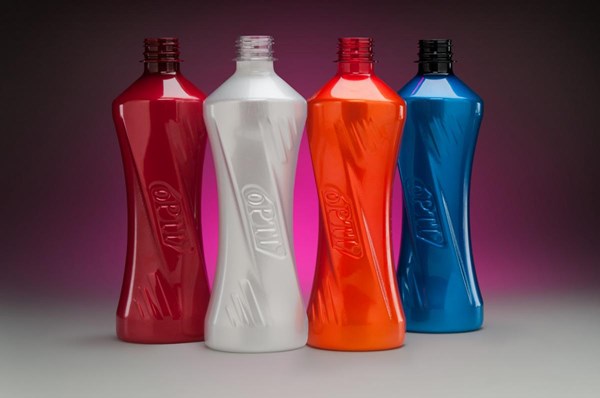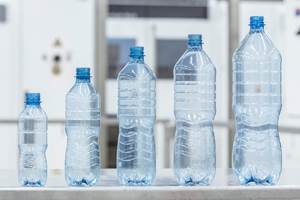Colored PET: Pretty To Look At; Headache For Recyclers
Plastics Recyclers of Europe believes that 'colorful’ future trends will weaken the image of PET as a recycled product.

oPTI lightweight foamed PET bottles from Plastic Technologies Inc (PTI). The company says the process enables white or silvery colored bottles to be made without additives.
PET. Thanks to its hygienic, strong and extremely lightweight characteristics, the packaging industry has embraced the material. And don’t forget that PET is the largest material recycled in both the U.S. and Europe. Traditionally, unpigmented PET has the highest value and the widest variety of end-use applications for recycling, according to the Association of Postconsumer Plastic Recyclers (APR, Washington, DC, USA).
But trends aren’t always about what’s easy and right now, many brands are taking a new path: colored packaging. The idea behind packaging with bright colors is pretty simple: it produces bottles with striking visual attributes and offers the potential to give brands differentiation in the marketplace. But this ‘colorful’ world of packaging could be problematic for recycling.
The trade group Plastics Recyclers Europe (PRE, Brussels, Belgium) recently discussed how the markets of milk packaging, home and personal care are switching from HDPE to PET for cost, marketing and sustainability reasons. However, this market shift could bring about more than 300,000 additional tones of colored PET, including black and white colors. PRE warns that the PET recycling markets can’t afford to absorb these extra colors.
“If collected and sorted together, these numerous colored containers will need extra sorting in the PET recycling plants,” the organization stated. “In order for recyclers to sell this colored fraction, the material will have to be tinted in black or grey, but no market currently exists for such a material in high quantities.”
According to the APR, the use of translucent and opaque colors is for bottle-to-bottle and engineered resin uses. Although newer sorting technology is capable of identifying white PET from other PET colors, much is also problematic and should be examined for their impact on the recycling process. Inclusion of nucleating agents, hazing agents, fluorescers and other additives for visual and technical effects should be examined specifically by the reclaiming industry for impact on the overall plastic bottle recycling stream, the APR states.
PRE says that its data shows that if PET milk bottles contain TiO2, the recyclers’ end product will be highly contaminated. For example, the transparency of clear recycled PET will be reduced (i.e. haze affect), while colored recycled PET will have TiO2 up to 5%. In both cases, this will lead to a fall in the use of recycled PET on the market, the group states.
“These ‘colorful’ future trends will weaken the image of PET as a recycled product. Additionally, it will create great difficulties for the PET recycling industry, which already has other market barriers to overcome,” the group said. “Furthermore, the existing HDPE recycling industry, which already has a market for colored HDPE applications (e.g. the pipe industry) will suffer if colored PET continues to grow.”
The solution? PRE believes its full body sleeves/labels that could still produce a colorful effect. But let’s not forget that full body shrink sleeve labels also present plenty of problems in the recycling process. PRE says it calls on the PET and HDPE value chains to join efforts to avoid breaking the circular functioning of these recycling streams.
What are your thoughts about this? Should PET have a colorful future?
Related Content
Brewer Chooses Quick-Change Flexibility to Blow Wide Range of PET Beer Bottles
Beermaster Brewery found a “universal” stretch-blow machine from PET Technologies enables multiple changes per day among four sizes of beer bottles.
Read MoreFor Extrusion and Injection-Blow Molders, Numerous Upgrades in Machines and Services
Uniloy is revising its machinery lines across the board and strengthening after-sales services in tooling maintenance, spare parts and tech service.
Read MoreFirst Water Bottles With Ultrathin Glass Coating
Long used for sensitive juices and carbonated soft drinks, KHS Freshsafe PET Plasmax vapor-deposited glass coating is now providing freshness and flavor protection for PET mineral water bottles.
Read MoreBreaking News From NPE2024
Here is a firsthand report of news in injection molding, extrusion, blow molding and recycling not previously covered.
Read MoreRead Next
People 4.0 – How to Get Buy-In from Your Staff for Industry 4.0 Systems
Implementing a production monitoring system as the foundation of a ‘smart factory’ is about integrating people with new technology as much as it is about integrating machines and computers. Here are tips from a company that has gone through the process.
Read MoreMaking the Circular Economy a Reality
Driven by brand owner demands and new worldwide legislation, the entire supply chain is working toward the shift to circularity, with some evidence the circular economy has already begun.
Read MoreBeyond Prototypes: 8 Ways the Plastics Industry Is Using 3D Printing
Plastics processors are finding applications for 3D printing around the plant and across the supply chain. Here are 8 examples to look for at NPE2024.
Read More














